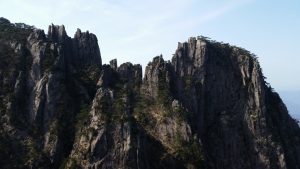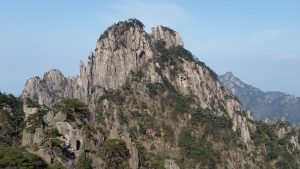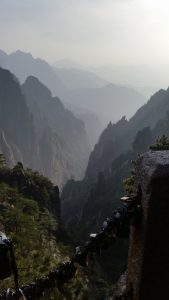 On my personal travels in China, my last stop before picking up my Imprint Tours group in Shanghai was incomparable Huangshan. Without planning it, I managed to save the best for last. I know I overuse the word, but WOW. I think the best way I might describe what Huangshan is like is to say it reminds me of the floating mountains in the movie Avatar. Huangshan is a mountainous region of eastern China that has been a tourist destination for the Chinese for decades. In fact, they promote themselves as the Origin of Chinese tourism. And they are spectacular!
On my personal travels in China, my last stop before picking up my Imprint Tours group in Shanghai was incomparable Huangshan. Without planning it, I managed to save the best for last. I know I overuse the word, but WOW. I think the best way I might describe what Huangshan is like is to say it reminds me of the floating mountains in the movie Avatar. Huangshan is a mountainous region of eastern China that has been a tourist destination for the Chinese for decades. In fact, they promote themselves as the Origin of Chinese tourism. And they are spectacular!
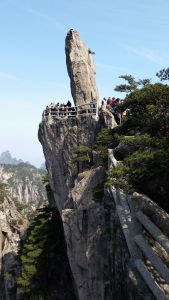 Once again, I had wonderful luck with the weather. Guidebooks warn the area gets lots of rain and can be socked in for days on end. But I had a perfect 24 hours on top with blue skies and clear air. I flew into the regional hub of Tunxi on a Friday, but arriving too late to get up to the mountains that day. But I headed up about midday next day, bussing to the support village of Tangkou, catching a shuttle up valley to the cable car station, which whisked me up several hundred feet to the peak area. True to the guidebook description, it was crawling with Chinese tourists.
Once again, I had wonderful luck with the weather. Guidebooks warn the area gets lots of rain and can be socked in for days on end. But I had a perfect 24 hours on top with blue skies and clear air. I flew into the regional hub of Tunxi on a Friday, but arriving too late to get up to the mountains that day. But I headed up about midday next day, bussing to the support village of Tangkou, catching a shuttle up valley to the cable car station, which whisked me up several hundred feet to the peak area. True to the guidebook description, it was crawling with Chinese tourists. 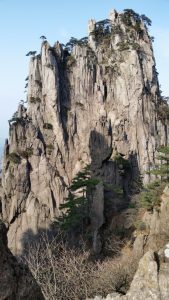 But as I have often found in my travels, places that are “touristy” and crowded are exactly so for a reason. And the reason here is obvious. The mountains of Huangshan are remarkable. The peaks are jagged, sharp, and splintered to a degree I’ve not seen elsewhere. Pinnacles and spires of rock, twisted and knarled mountain pines, and the amazing rock formations make this a fairytale landscape to explore. The peaks have been twisted into fantastical shapes by the forces of nature and the result is breathtaking. And of course, the Chinese have assigned fanciful names to the various formations. My favorite was Monkey Praying to the Sea (see featured image at top of this blog) – which does not require too much imagination to see. Pinnacle with a Paintbrush was less a favorite, but cleverly named. Big Toe was obvious and truly astonishing, crowded with tourist snapping photographs and selfies like there is no tomorrow.
But as I have often found in my travels, places that are “touristy” and crowded are exactly so for a reason. And the reason here is obvious. The mountains of Huangshan are remarkable. The peaks are jagged, sharp, and splintered to a degree I’ve not seen elsewhere. Pinnacles and spires of rock, twisted and knarled mountain pines, and the amazing rock formations make this a fairytale landscape to explore. The peaks have been twisted into fantastical shapes by the forces of nature and the result is breathtaking. And of course, the Chinese have assigned fanciful names to the various formations. My favorite was Monkey Praying to the Sea (see featured image at top of this blog) – which does not require too much imagination to see. Pinnacle with a Paintbrush was less a favorite, but cleverly named. Big Toe was obvious and truly astonishing, crowded with tourist snapping photographs and selfies like there is no tomorrow.
 I got off the cable car about 3:00PM and had a fantastic couple of hours winding my way along well-groomed and railed pathways and through the crowds of Chinese. The infrastructure up here is almost as impressive as the resource. Steps have been cut into rock faces, secure and well maintined stone railings edge every dangerous section of trail, and hanging walkways provide access virtually everywhere. The adrenaline was pumping as I pumped photographs and enjoyed the pristine, fresh air (a real treat in China!). I summited a couple of peaks and stopped at many viewpoints. I reached my hotel about 5:30, got checked in, and headed out again.
I got off the cable car about 3:00PM and had a fantastic couple of hours winding my way along well-groomed and railed pathways and through the crowds of Chinese. The infrastructure up here is almost as impressive as the resource. Steps have been cut into rock faces, secure and well maintined stone railings edge every dangerous section of trail, and hanging walkways provide access virtually everywhere. The adrenaline was pumping as I pumped photographs and enjoyed the pristine, fresh air (a real treat in China!). I summited a couple of peaks and stopped at many viewpoints. I reached my hotel about 5:30, got checked in, and headed out again. 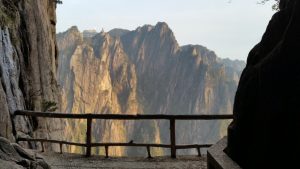 The rays of the late day sun had turned golden and the photogenic peaks, pinnacles, escarpments, and ridges were even more impressive. I didn’t have to walk far for lovely vistas of golden rocks in the foreground and misty, hazy purple hills stretching out to the background horizon.
The rays of the late day sun had turned golden and the photogenic peaks, pinnacles, escarpments, and ridges were even more impressive. I didn’t have to walk far for lovely vistas of golden rocks in the foreground and misty, hazy purple hills stretching out to the background horizon.
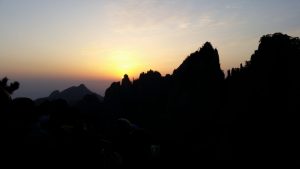 The next morning I rose early and headed out for sunrise. It was not spectacular, but it was certainly very nice and I got some nice shots of Monkey Praying to the Sea. I returned to my hotel for a hot breakfast and then checked out. I had intended to hike the short route to the 2nd cable car and go down, but I managed to miss the cut-off (apparently) and ended up hiking clear across the summit area and back to my arrival cable car. No worries, as it was a particularly clear morning, making for many more new, very clear vistas. It was a spectacular and memorable morning and I had the entire afternoon to make my leisurely way back to Tunxi.
The next morning I rose early and headed out for sunrise. It was not spectacular, but it was certainly very nice and I got some nice shots of Monkey Praying to the Sea. I returned to my hotel for a hot breakfast and then checked out. I had intended to hike the short route to the 2nd cable car and go down, but I managed to miss the cut-off (apparently) and ended up hiking clear across the summit area and back to my arrival cable car. No worries, as it was a particularly clear morning, making for many more new, very clear vistas. It was a spectacular and memorable morning and I had the entire afternoon to make my leisurely way back to Tunxi.